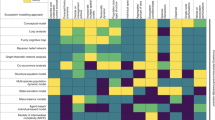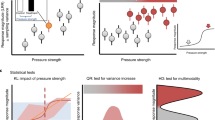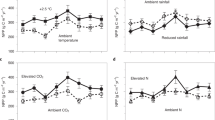Abstract
Despite great advances, experiments concerning the response of ecosystems to climate change still face considerable challenges, including the high complexity of climate change in terms of environmental variables, constraints in the number and amplitude of climate treatment levels, and the limited scope of responses and interactions covered. Drawing on the expertise of researchers from a variety of disciplines, this Perspective outlines how computational and technological advances can help in designing experiments that can contribute to overcoming these challenges, and also outlines a first application of such an experimental design.
This is a preview of subscription content, access via your institution
Access options
Access Nature and 54 other Nature Portfolio journals
Get Nature+, our best-value online-access subscription
$29.99 / 30 days
cancel any time
Subscribe to this journal
Receive 12 print issues and online access
$209.00 per year
only $17.42 per issue
Buy this article
- Purchase on Springer Link
- Instant access to full article PDF
Prices may be subject to local taxes which are calculated during checkout



Similar content being viewed by others
References
Scheffers, B. R. et al. The broad footprint of climate change from genes to biomes to people. Science 354, aaf7671 (2016).
Zhao, C. et al. Temperature increase reduces global yields of major crops in four independent estimates. Proc. Natl Acad. Sci. USA 114, 9326–9331 (2017).
Allen, C. D. et al. A global overview of drought and heat-induced tree mortality reveals emerging climate change risks for forests. Ecol. Manag. 259, 660–684 (2010).
Hatfield, J. L. & Prueger, J. H. Temperature extremes: effect on plant growth and development. Weather Clim. Extremes 10, 4–10 (2015).
Collins, M. et al. in Climate Change 2013: The Physical Science Basis (eds. Stocker, T. F. et al.) 1029–1136 (IPCC, Cambridge Univ. Press, 2013).
Pecl, G. T. et al. Biodiversity redistribution under climate change: impacts on ecosystems and human well-being. Science 355, eaai9214 (2017).
Millenium Ecosystem Assessment. Ecosystems and Human Well-being: Synthesis (Island, 2005); https://doi.org/10.1196/annals.1439.003
Leuzinger, S. et al. Do global change experiments overestimate impacts on terrestrial ecosystems? Trends Ecol. Evol. 26, 236–241 (2011).
Stewart, R. I. A. et al. Mesocosm experiments as a tool for ecological climate-change research. Adv. Ecol. Res. 48, 71–181 (2013).
Zscheischler, J. & Seneviratne, S. I. Dependence of drivers affects risks associated with compound events. Sci. Adv. 3, e1700263 (2017).
Guillod, B. P., Orlowsky, B., Miralles, D. G., Teuling, A. J. & Seneviratne, S. I. Reconciling spatial and temporal soil moisture effects on afternoon rainfall. Nat. Commun. 6, 6443 (2015).
Thiery, W. et al. Hazardous thunderstorm intensification over Lake Victoria. Nat. Commun. 7, 12786 (2016).
Berendse, F., Schmitz, M. & Visser, W. De Experimental manipulation of succession in heathland ecosystems. Oecologia 100, 38–44 (1994).
Backhaus, S. et al. Recurrent mild drought events increase resistance toward extreme drought stress. Ecosystems 17, 1068–1081 (2014).
Verburg, P. S. J. et al. Impacts of an anomalously warm year on soil nitrogen availability in experimentally manipulated intact tallgrass prairie ecosystems. Glob. Change Biol. 15, 888–900 (2009).
Roy, J. et al. Elevated CO2 maintains grassland net carbon uptake under a future heat and drought extreme. Proc. Natl Acad. Sci. USA 113, 6224–6229 (2016).
Cantarel, A. M. & Bloor, J. M. G. Four years of simulated climate change reduces above-ground productivity and alters functional diversity in a grassland ecosystem. J. Veg. Sci. 24, 113–126 (2013).
Kreyling, J. et al. To replicate, or not to replicate — that is the question: how to tackle nonlinear responses in ecological experiments. Ecol. Lett. https://doi.org/10.1111/ele.13134 (2018).
Zhou, X., Weng, E. & Luo, Y. Modeling patterns of nonlinearity in ecosystem responses to temperature, CO2, and precipitation changes. Ecol. Appl. 18, 453–466 (2008).
Luo, Y. et al. Modeled interactive effects of precipitation, temperature, and [CO2] on ecosystem carbon and water dynamics in different climatic zones. Glob. Change Biol. 14, 1986–1999 (2008).
Kayler, Z. E. et al. Experiments to confront the environmental extremes of climate change. Front. Ecol. Environ. https://doi.org/10.1890/140174 (2015).
Svenning, J. C. & Sandel, B. Disequilibrium vegetation dynamics under future climate change. Am. J. Bot. 100, 1266–1286 (2013).
Harris, R. M. B. et al. Biological responses to the press and pulse of climate trends and extreme events. Nat. Clim. Change 8, 579–587 (2018).
Scheffer, M., Carpenter, S., Foley, J. A., Folke, C. & Walker, B. Catastrophic shifts in ecosystems. Nature 413, 591–596 (2001).
Hein, C. J. et al. Overcoming early career barriers to interdisciplinary climate change research. WIREs Clim. Change 9, 1–18 (2018).
Xu, X., Goswami, S., Gulledge, J., Wullschleger, S. D. & Thornton, P. E. Interdisciplinary research in climate and energy sciences. WIREs Energy Environ. 5, 49–56 (2016).
Sievanen, L., Campbell, L. M. & Leslie, H. M. Challenges to interdisciplinary research in ecosystem-based management. Conserv. Biol. 26, 315–323 (2012).
Abiven, S. et al. Integrative research efforts at the boundary of biodiversity and global change research. Curr. Opin. Environ. Sustain. 29, 215–222 (2017).
Bromham, L., Dinnage, R. & Hua, X. Interdisciplinary research has consistently lower funding success. Nature 534, 684–687 (2016).
Turner, L. M. et al. Transporting ideas between marine and social sciences: experiences from interdisciplinary research programs. Elem. Sci. Anth. 5, 14 (2017).
Hellsten, I. & Leydesdorff, L. The construction of interdisciplinarity: the development of the knowledge base and programmatic focus of the journal Climatic Change, 1977–2013. J. Assoc. Inf. Sci. Technol. 67, 2181–2193 (2016).
Boerema, A., Rebelo, A. J., Bodi, M. B., Esler, K. J. & Meire, P. Are ecosystem services adequately quantified? J. Appl. Ecol. 54, 358–370 (2017).
Clobert, J. et al. How to integrate experimental research approaches in ecological and environmental studies: AnaEE France as an example. Front. Ecol. Evol. https://doi.org/10.3389/fevo.2018.00043 (2018).
Mougin, C. et al. A coordinated set of ecosystem research platforms open to international research in ecotoxicology, AnaEE-France. Environ. Sci. Pollut. Res. 22, 16215–16228 (2015).
Eisenhauer, N. & Türke, M. From climate chambers to biodiversity chambers. Front. Ecol. Environ. 16, 136–137 (2018).
Milcu, A. et al. Functional diversity of leaf nitrogen concentrations drives grassland carbon fluxes. Ecol. Lett. 17, 435–444 (2014).
Cottingham, K. L., Lennon, J. T. & Brown, B. L. Knowing when to draw the line: designing more informative ecological experiments. Front. Ecol. Environ. 3, 145–152 (2005).
Van der Biest, K. et al. Evaluation of the accuracy of land-use based ecosystem service assessments for different thematic resolutions. J. Environ. Manag. 156, 41–51 (2015).
Polasky, S. & Segerson, K. Integrating ecology and economics in the study of ecosystem services: some lessons learned. Annu. Rev. Resour. Econ. 1, 409–434 (2009).
Costanza, R. et al. Changes in the global value of ecosystem services. Glob. Environ. Change 26, 152–158 (2014).
Braat, L. C. & de Groot, R. The ecosystem services agenda: bridging the worlds of natural science and economics, conservation and development, and public and private policy. Ecosyst. Serv. 1, 4–15 (2012).
Plaas, E. et al. Towards valuation of biodiversity in agricultural soils: a case for earthworms. Ecol. Econ. 159, 291–300 (2019).
Brouwers, J. et al. MIRA Climate Report 2015: About Observed and Future Climate Changes in Flanders and Belgium (Flanders Environment Agency, 2015); https://doi.org/10.13140/RG.2.1.2055.8809
Klein Tank, A. M. G. et al. Daily dataset of 20th-century surface air temperature and precipitation series for the European Climate Assessment. Int. J. Climatol. 22, 1441–1453 (2002).
van Vuuren, D. P. et al. The representative concentration pathways: an overview. Clim. Change 109, 5–31 (2011).
Seneviratne, S. I., Donat, M. G., Pitman, A. J., Knutti, R. & Wilby, R. L. Allowable CO2 emissions based on regional and impact-related climate targets. Nature 529, 477–483 (2016).
UNFCCC. Paris Climate Change Conference November 2015, COP 21. Adoption of the Paris Agreement. Proposal by the President 21932, 32 (UNFCCC, 2015).
Smith, J. et al. Estimating changes in Scottish soil carbon stocks using ECOSSE. II. Application. Clim. Res. 45, 193–205 (2010).
Schaubroeck, T. et al. Environmental impact assessment and monetary ecosystem service valuation of an ecosystem under different future environmental change and management scenarios; a case study of a Scots pine forest. J. Environ. Manag. 173, 79–94 (2016).
Hunter, J. E. & Schmidt, F. L. Cumulative research knowledge and social policy formulation: the critical role of meta-analysis. Psychol. Public Policy Law 2, 324–347 (1996).
Gerstner, K. et al. Will your paper be used in a meta-analysis? Make the reach of your research broader and longer lasting. Methods Ecol. Evol. 8, 777–784 (2017).
Knapp, A. K. et al. Past, present, and future roles of long-term experiments in the LTER network. 62, 377–389 (2012).
De Boeck, H., Dreesen, F. E., Janssens, I. A. & Nijs, I. Climatic characteristics of heat waves and their simulation in plant experiments. Glob. Change Biol. 16, 1992–2000 (2010).
Fraser, L. H. et al. Coordinated distributed experiments: an emerging tool for testing global hypotheses in ecology and environmental science. Front. Ecol. Environ. https://doi.org/10.1890/110279 (2013).
Lind, E. M. et al. Life-history constraints in grassland plant species : a growth-defence trade-off is the norm. Ecol. Lett. 16, 513–521 (2013).
Keller, M., Schimel, D. S., Hargrove, W. W. & Hoffman, F. M. A continental strategy for the National Ecological Observatory Network. Front. Ecol. Environ. 6, 282–284 (2008).
Smith, P. et al. Towards an integrated global framework to assess the impacts of land use and management change on soil carbon: current capability and future vision. Glob. Change Biol. 18, 2089–2101 (2012).
Richards, M. et al. High-resolution spatial modelling of greenhouse gas emissions from land-use change to energy crops in the United Kingdom. GCB Bioenergy 44, 627–644 (2017).
Song, J. et al. A meta-analysis of 1,119 manipulative experiments on terrestrial carbon-cycling responses to global change. Nat. Ecol. Evol. 3, 1309–1320 (2019).
Acknowledgements
We thank the Flemish government (through Hercules Stichting big infrastructure and the Fund for Scientific Research Flanders project G0H4117N) and LSM (Limburg Sterk Merk, project 271) for providing funds to build the UHasselt Ecotron; Hasselt University for both funding and policy support (project BOF12BR01 and Methusalem project 08M03VGRJ); and the ecotron research committee for comments on the experimental design. We also thank Regional Landscape Kempen and Maasland for its collaboration and support. N.W., S.L., A.N. and I.V. are funded by Research Foundation-Flanders (FWO).
Author information
Authors and Affiliations
Contributions
F.R. and R.M. took the lead in writing the manuscript and received input from all co-authors. The initial conceptualization of this manuscript was discussed during a consortium meeting. All authors proofread and provided their input to different draft versions and gave their final approval for submission.
Corresponding author
Ethics declarations
Competing interests
The authors declare no competing interests.
Additional information
Publisher’s note Springer Nature remains neutral with regard to jurisdictional claims in published maps and institutional affiliations.
Supplementary information
Supplementary Information
Supplementary Figs 1–4, Supplementary references
Rights and permissions
About this article
Cite this article
Rineau, F., Malina, R., Beenaerts, N. et al. Towards more predictive and interdisciplinary climate change ecosystem experiments. Nat. Clim. Chang. 9, 809–816 (2019). https://doi.org/10.1038/s41558-019-0609-3
Received:
Accepted:
Published:
Issue Date:
DOI: https://doi.org/10.1038/s41558-019-0609-3
This article is cited by
-
Global diversity and biogeography of potential phytopathogenic fungi in a changing world
Nature Communications (2023)
-
Relationships of temperature and biodiversity with stability of natural aquatic food webs
Nature Communications (2023)
-
Change in heathland dominant plants strongly increases C mineralization potential despite marginally affecting microbial community structure
Plant and Soil (2022)
-
A millennium-long climate history of erosive storms across the Tiber River Basin, Italy, from 725 to 2019 CE
Scientific Reports (2021)
-
A novel method for assessing climate change impacts in ecotron experiments
International Journal of Biometeorology (2020)



